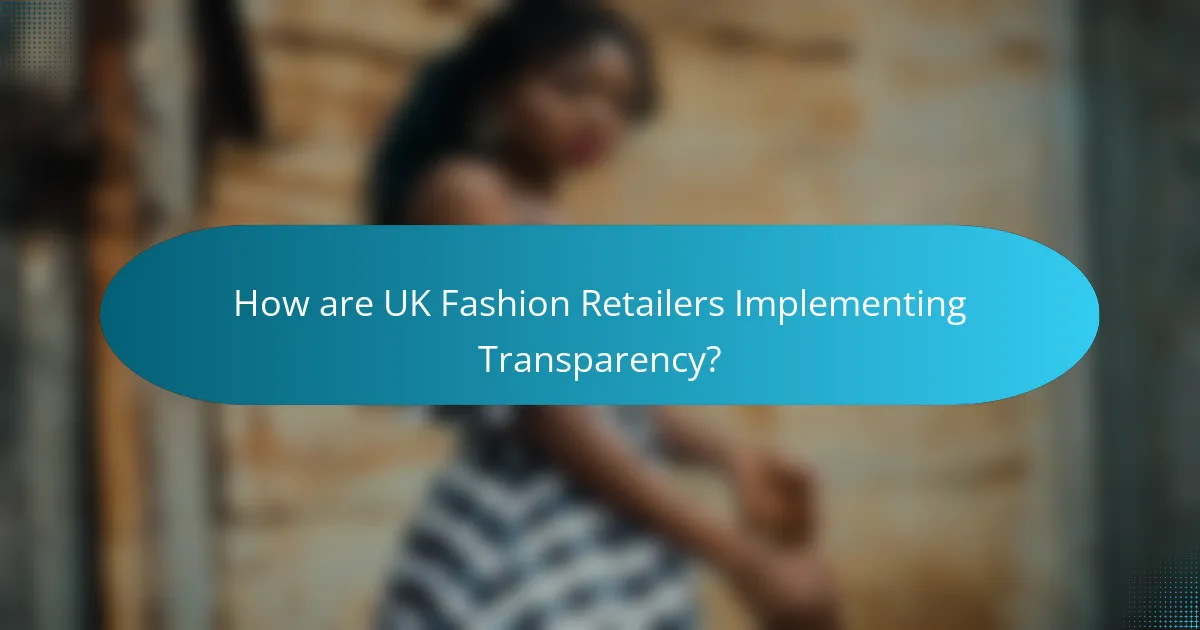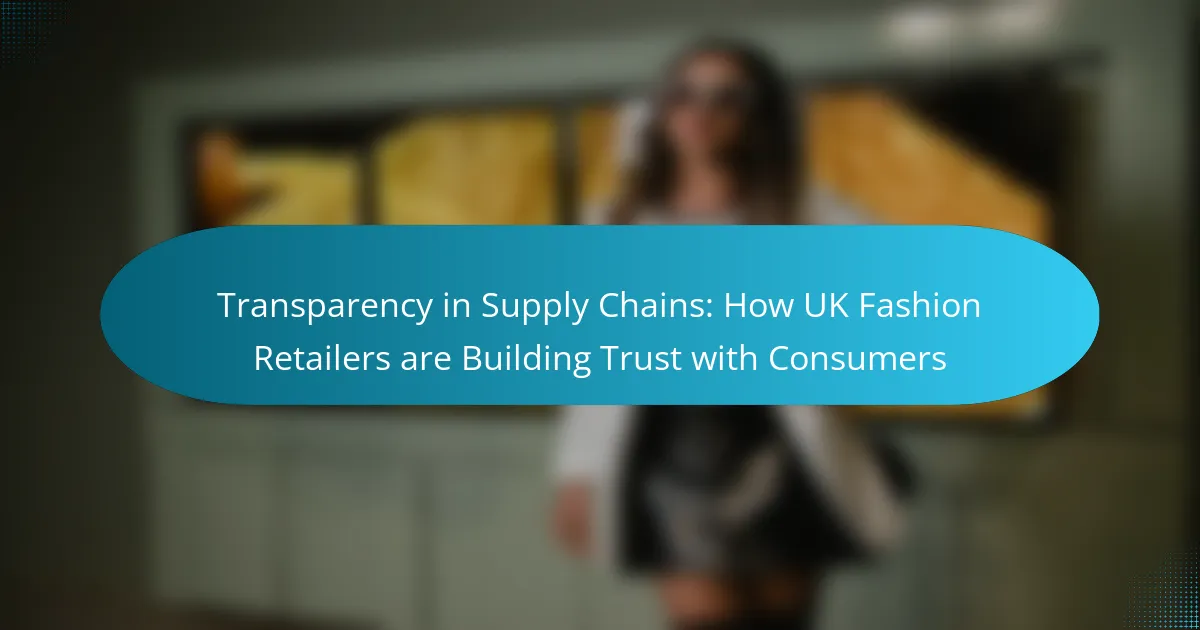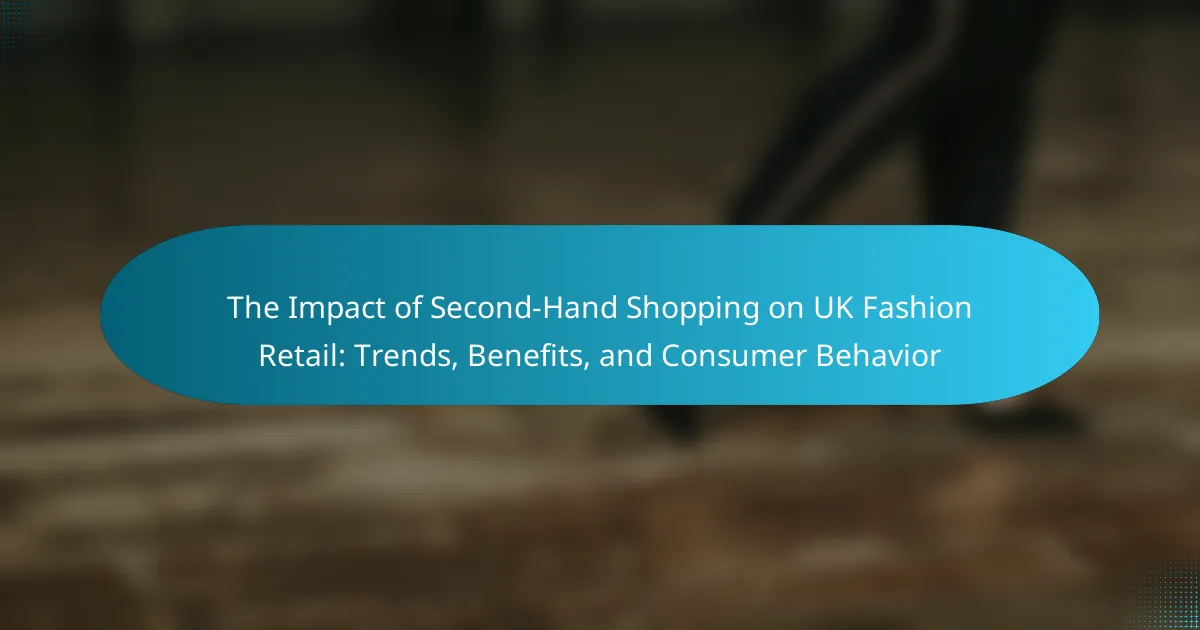
What is Transparency in Supply Chains?
Transparency in supply chains refers to the openness and clarity regarding the processes, practices, and origins of products within a supply chain. It involves providing stakeholders with accessible information about sourcing, production, and distribution. This transparency helps consumers make informed decisions about the ethical and environmental impact of their purchases. Research indicates that 66% of consumers are willing to pay more for sustainable brands. Transparency builds trust between retailers and consumers, fostering loyalty and encouraging responsible consumption.
How does transparency impact consumer trust in the fashion industry?
Transparency significantly enhances consumer trust in the fashion industry. When brands openly share information about their supply chains, it fosters a sense of honesty. Consumers are more likely to trust brands that disclose their sourcing, manufacturing processes, and labor practices. According to a survey by McKinsey, 67% of consumers consider transparency a key factor in their purchasing decisions. Additionally, brands that engage in transparent practices can differentiate themselves in a competitive market. This transparency can lead to increased customer loyalty and repeat purchases. Ultimately, a commitment to transparency aligns with consumer values, particularly regarding sustainability and ethical practices.
What are the key elements of transparency in supply chains?
Key elements of transparency in supply chains include visibility, traceability, and accountability. Visibility allows stakeholders to see the entire supply chain process. Traceability enables tracking of products from origin to consumer. Accountability ensures that all parties adhere to ethical standards and practices. These elements foster trust and informed decision-making among consumers. Research shows that 94% of consumers are more likely to be loyal to a brand that offers complete transparency.
How do UK fashion retailers define transparency?
UK fashion retailers define transparency as the clear communication of supply chain practices. This includes sharing information about sourcing, production processes, and labor conditions. Retailers aim to provide consumers with insights into where and how products are made. Transparency also involves disclosing environmental impact and sustainability efforts. Many retailers publish sustainability reports to outline their commitments and progress. This approach builds consumer trust and accountability. According to a survey by the Ethical Consumer, 78% of consumers prefer brands that are transparent about their supply chains. Therefore, transparency is increasingly seen as essential for brand loyalty in the UK fashion industry.
Why is transparency important for UK fashion retailers?
Transparency is important for UK fashion retailers because it builds consumer trust. Consumers increasingly demand ethical practices in the fashion industry. They want to know how products are made and sourced. Transparency helps retailers demonstrate their commitment to sustainability. It also allows consumers to make informed purchasing decisions. According to a 2021 survey by McKinsey, 66% of consumers consider sustainability when shopping. Retailers who provide clear information about their supply chains can differentiate themselves in a competitive market. This approach can lead to increased customer loyalty and sales.
What are the potential risks of a non-transparent supply chain?
A non-transparent supply chain poses several potential risks. These risks include increased vulnerability to unethical practices. Companies may inadvertently support child labor or unsafe working conditions without visibility into their supply chain. Financial losses can occur due to supply chain disruptions that are not detected early. Lack of transparency can lead to reputational damage when consumers become aware of unethical practices. Regulatory compliance issues may arise if companies fail to adhere to laws related to supply chain transparency. Additionally, it can result in inefficiencies and higher costs due to a lack of accountability among suppliers. Overall, these risks highlight the importance of transparency in maintaining ethical and operational standards.
How does transparency contribute to brand loyalty?
Transparency builds brand loyalty by fostering trust between consumers and brands. When brands openly share information about their supply chains, customers feel more informed and empowered. This openness reduces skepticism and enhances credibility. According to a 2021 study by Label Insight, 94% of consumers are more likely to be loyal to a brand that offers complete transparency. Furthermore, transparency helps brands align with consumer values, particularly around ethical practices. When consumers see brands prioritizing sustainability and ethical sourcing, they are more likely to remain loyal. This connection between transparency and loyalty is essential in the competitive fashion retail market.

How are UK Fashion Retailers Implementing Transparency?
UK fashion retailers are implementing transparency through detailed supply chain disclosures. They are providing information on sourcing practices, production processes, and labor conditions. Many retailers publish sustainability reports that outline their environmental impact. Some brands utilize blockchain technology to trace the origins of their materials. This allows consumers to verify ethical practices independently. Additionally, retailers are engaging with third-party audits to ensure compliance with transparency standards. Initiatives like the Fashion Transparency Index rank brands based on their disclosure efforts. These steps aim to build consumer trust and promote ethical consumption.
What strategies are UK fashion retailers using to enhance transparency?
UK fashion retailers are employing several strategies to enhance transparency. They are increasingly sharing information about their supply chains. This includes revealing the origins of materials and labor practices. Many brands are adopting traceability technologies, such as blockchain. These technologies allow consumers to track the journey of products. Retailers are also publishing sustainability reports regularly. These reports detail environmental impacts and ethical practices. Collaborations with third-party organizations for audits are common. This adds credibility to their transparency claims. Additionally, brands are engaging consumers through social media. They encourage discussions about ethical fashion choices.
How do retailers communicate their supply chain practices to consumers?
Retailers communicate their supply chain practices to consumers through various channels. They utilize websites to provide detailed information about sourcing and production processes. Social media platforms are also employed to share updates and engage with consumers directly. Transparency reports are published to outline sustainability efforts and ethical practices. Many retailers participate in third-party certifications to validate their claims. Labels on products often include information about supply chain origins. Additionally, some retailers host events to educate consumers about their practices. This multifaceted approach fosters trust and accountability among consumers.
What role does technology play in improving supply chain transparency?
Technology enhances supply chain transparency by enabling real-time data sharing and tracking. It allows stakeholders to access information about product origins, manufacturing processes, and logistics. Technologies such as blockchain provide immutable records that confirm product authenticity. Internet of Things (IoT) devices facilitate monitoring of goods throughout the supply chain. Advanced analytics can identify inefficiencies and risks, promoting proactive decision-making. According to a study by Deloitte, 79% of organizations believe that supply chain transparency is important for customer trust. These technological advancements collectively foster greater accountability and sustainability in supply chains.
What challenges do UK fashion retailers face in achieving transparency?
UK fashion retailers face several challenges in achieving transparency. One significant challenge is the complexity of supply chains. Many retailers source materials and products from multiple suppliers across different countries. This makes tracking the origin and production processes difficult.
Another challenge is the lack of standardized reporting practices. Different brands may use varying metrics and definitions for transparency. This inconsistency can confuse consumers and undermine trust.
Additionally, there is pressure to maintain competitive pricing. Retailers may prioritize cost over transparency, leading to less disclosure about sourcing practices. This can hinder efforts to provide clear information to consumers.
Moreover, some retailers face resistance from suppliers. Suppliers may be reluctant to share information due to concerns about competitive advantage or reputational risks. This can create barriers to full transparency.
Finally, regulatory frameworks are still evolving. Current regulations may not adequately support transparency initiatives. This can leave retailers without clear guidelines on how to disclose information effectively.
How can retailers overcome obstacles to transparency?
Retailers can overcome obstacles to transparency by implementing clear communication strategies. They should provide detailed information about sourcing and production processes. Utilizing technology, such as blockchain, can enhance traceability in supply chains. Engaging with consumers through social media can foster open dialogue and build trust. Training employees on transparency practices is essential for consistent messaging. Collaborating with suppliers to ensure compliance with transparency standards is also crucial. According to a 2021 report by McKinsey, transparency can lead to increased consumer loyalty and brand reputation.
What are common misconceptions about supply chain transparency?
Common misconceptions about supply chain transparency include the belief that it guarantees complete visibility into all processes. Many think that transparency means knowing every detail of the supply chain, which is often impractical. Another misconception is that transparency only involves disclosing supplier names. In reality, it encompasses sharing information about practices, labor conditions, and sustainability efforts. Some assume that increased transparency automatically leads to improved ethical standards. However, transparency must be paired with accountability to effect real change. Additionally, many believe that transparency is only relevant for large companies. In fact, businesses of all sizes can benefit from adopting transparent practices.

What are the Benefits of Transparency in Supply Chains for Consumers?
Transparency in supply chains benefits consumers by enhancing trust and informed decision-making. Consumers gain insight into product origins, ensuring ethical sourcing practices. This knowledge helps them support brands that align with their values. Transparency also fosters accountability among retailers, leading to improved product quality. According to a 2021 study by McKinsey, 66% of consumers are willing to pay more for sustainable brands. Additionally, transparency can reduce the risk of fraud and misleading claims. By understanding supply chain processes, consumers can make choices that promote sustainability and ethical labor practices.
How does transparency influence consumer purchasing decisions?
Transparency significantly influences consumer purchasing decisions by fostering trust. When consumers perceive a brand as transparent, they are more likely to engage with it. A study by Label Insight found that 94% of consumers are likely to be loyal to a brand that offers complete transparency. Transparency also enhances perceived product value and quality. Brands that disclose sourcing, manufacturing practices, and ingredient information tend to attract more conscientious consumers. Furthermore, transparency can lead to positive word-of-mouth and brand advocacy. This is crucial in the competitive fashion retail market, where ethical concerns are increasingly prioritized by consumers.
What are the ethical implications of transparency for consumers?
Transparency for consumers involves clear communication about product sourcing, manufacturing practices, and corporate policies. Ethical implications include informed consumer choices and accountability for brands. When consumers understand product origins, they can make decisions aligned with their values. This transparency fosters trust between consumers and brands. Additionally, it encourages ethical practices within supply chains. Research indicates that 73% of consumers prefer brands that are transparent about their practices. Such transparency can lead to increased customer loyalty and brand reputation.
How can consumers verify the claims made by fashion retailers?
Consumers can verify the claims made by fashion retailers by researching the brand’s supply chain practices. They can check for certifications like Fair Trade or GOTS, which indicate ethical standards. Reading customer reviews can provide insights into product quality and authenticity. Additionally, consumers can visit the retailer’s website for transparency reports detailing sourcing and labor practices. Engaging with third-party watchdog organizations can also offer reliable information. Social media platforms may reveal consumer experiences that highlight discrepancies in claims. Finally, consumers can contact retailers directly to ask questions about their sustainability and ethical practices.
What best practices should consumers consider regarding supply chain transparency?
Consumers should prioritize brands that openly share their supply chain practices. Transparency includes disclosing sourcing locations and labor conditions. Consumers can research a brand’s commitment to ethical sourcing. They should look for certifications like Fair Trade or Global Organic Textile Standard. Engaging with brands through social media can prompt them to provide more information. Reading reviews can also reveal consumer experiences regarding transparency. Attending events or forums on ethical fashion can enhance understanding. Supporting brands that advocate for transparency fosters industry-wide changes.
How can consumers support brands that prioritize transparency?
Consumers can support brands that prioritize transparency by choosing to purchase their products. By buying from these brands, consumers reinforce the importance of ethical practices. They can also engage with these brands on social media. This engagement can amplify the message of transparency. Sharing positive experiences with transparent brands can influence others. Additionally, consumers can provide feedback to brands about their transparency efforts. This feedback encourages brands to maintain or improve their practices. Research shows that 73% of consumers are willing to pay more for sustainable products. Thus, consumer support directly impacts brand practices and industry standards.
What resources are available for consumers to learn more about supply chain transparency?
Consumers can learn more about supply chain transparency through various resources. Educational websites provide information on best practices and standards. Non-profit organizations often publish reports and guidelines on transparency. Industry associations also offer resources and tools for consumers. Online courses and webinars cover supply chain management topics. Social media platforms feature discussions and insights from experts. Transparency indexes rank companies based on their supply chain practices. Research studies provide data and analysis on transparency trends. Government publications outline regulations and compliance requirements in supply chains.
Transparency in supply chains refers to the clarity and openness regarding the processes and origins of products, particularly in the fashion industry. This article examines how UK fashion retailers are implementing transparency to build consumer trust, detailing key elements such as visibility, traceability, and accountability. It highlights the impact of transparency on consumer purchasing decisions, brand loyalty, and the ethical implications for consumers. Additionally, the article addresses challenges retailers face in achieving transparency and offers insights on how consumers can verify claims and support transparent brands.



